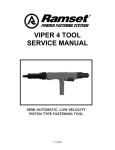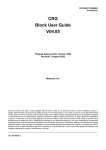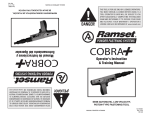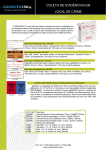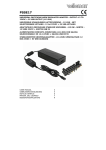Download RAMSET Viper Tool Operating instructions
Transcript
DANGER THIS TOOL FOR USE BY LICENSED OPERATORS ONLY. READ AND OBEY ALL SAFETY AND OPERATING INSTRUCTIONS BEFORE OPERATING TOOL. VIPER TOOL OPERATOR’S SAFETY & OPERATING INSTRUCTION MANUAL SEMI-AUTOMATIC, LOW VELOCITY PISTON TYPE FASTENING TOOL DANGER SAFETY INTRODUCTION DANGER THIS TOOL IS TO BE USED ONLY BY PROPERLY TRAINED AND LICENSED OPERATORS. YOU MUST SUCCESSFULLY COMPLETE ITW RAMSET/RED HEAD’S TRAINING PROGRAM FOR THE TOOL AND OBTAIN A CERTIFIED OPERATOR’S LICENSE BEFORE HANDLING, LOADING OR OPERATING THIS TOOL. ATTEMPTING TO HANDLE OR OPERATE THIS TOOL WITHOUT PROPER TRAINING AND LICENSING CAN RESULT IN SERIOUS INJURY TO THE OPERATOR OR BYSTANDERS. Operator’s and bystanders must wear eye and hearing protection. Read manual before operating tool. Never close tool with hand over fastener loading end of the tool. A serious hand injury from penetration by the piston or a discharged fastener could result. DANGER Just as no one can merely read a book about driving an automobile and then hope to drive one safely, no one should attempt to use any Ramset tool without adequate, competent personal instruction. And just as one must be licensed to drive an automobile, one must also be licensed to use a powder actuated tool. No automobile instruction book or instructor can forewarn a learner against all possibilities and emergencies, nor can ITW Ramset/Red Head instructors and printed material detail all possible conditions surrounding the use of ITW Ramset/Red Head tools and products. Responsibility for the safe and proper use of this tool rests with the tool user and the employer. SAFETY INTRODUCTION 2 DANGER SAFETY INSTRUCTIONS DANGER Preparation Acceptable Base Materials Powder actuated fastening is suitable for use in the following base materials only: • Poured Concrete • Structural Steel • Masonry Joints ( see page 8) Never attempt to fasten into any other type of material. Fastening into other materials can cause blindness or other serious injury. NEVER FASTEN INTO VERY HARD OR BRITTLE MATERIALS Unacceptable Base Materials Never attempt to fasten into very hard or brittle materials such as cast iron, tile, glass, or rock of any type. These materials can shatter, causing the fastener and/or base material fragments to fly free and cause serious injury to the tool operator and others. Never fasten into soft base materials, such as drywall or lumber products. These materials may allow the fastener to travel completely through and out the other side, endangering those in the path of the fastener. Never fasten into any base material that does not pass the Center Punch test. Failure to assure the suitability of the base material can result in serious injury to the eyes or other body parts. Center Punch Test ALWAYS WEAR SAFETY GOGGLES WHEN PERFORMING THIS TEST. 1. Always check the material being fastened into for hardness before attempting any fastening operation. 2. Using a fastener as a center punch, strike the fastener against the work surface using an average hammer blow and check the results. DANGER NEVER FASTEN INTO SOFT MATERIALS SUCH AS DRYWALL Center Punch Test Results 1. If the fastener point is flattened, the material is too hard for a powder actuated fastening. 2. If the fastener penetrates the material easily, the material is too soft. 3. If the material cracks or shatters, the material is too brittle. 4. If the fastener makes a small indentation into the material, the material is suitable for fastening. SAFETY INSTRUCTIONS 3 DANGER SAFETY INSTRUCTIONS Loads & Load Selection Safety 1. Always make a test fastening after being sure that the base material is suitable for powder actuated fastening. Failure to determine the correct power level to be used may result in the use of excessive power, allowing the fastener to pass completely through the work material, causing serious or fatal injuries to others who may be in the path of the fastener. 2. Color-blind operators must always select loads by load number to prevent use of an incorrect load for the same reasons as in #1 above. Workplace Safety 1. Operators and bystanders must always wear approved safety goggles and approved hearing protection. Failure to do so may result in blindness or serious eye injury from flying debris and loss of hearing from constant or repeated unprotected exposure to fastening noise. 2. Always keep the work area clear of bystanders and unnecessary materials that could interfere with safe tool operation. Operating the tool in a congested or cluttered area may affect your ability to operate the tool safely. 3. Never operate tool if flammable or explosive materials are nearby. Powder loads burn and create sparks when fired and could ignite these materials or fumes. 4. Always post warning signs within 50’ of the area where fastening is to be done. Sign must state: “Caution- Powder Actuated Tool In Use”. Failure to warn others may result in serious injury to them. Contact ITW Ramset/ Red Head at 1-800-354-7432 to obtain this sign. SAFETY INSTRUCTIONS 4 ALWAYS MAKE A TEST FASTENING 4 COLOR-BLIND OPERATORS MUST ALWAYS SELECT LOADS BY NUMBER KEEP WORK AREA CLEAR OF BYSTANDERS AND CLUTTER NEVER OPERATE TOOL AROUND FLAMMABLE OR EXPLOSIVE MATERIALS ALWAYS POST WARNING SIGNS DANGER DANGER SAFETY INSTRUCTIONS Tool Handling Safety 1. Always be sure tool is operating properly before attempting to use it. Follow the “Daily Function Check” shown to the right and described on page 9. 2. Always load tool using a load strip selected directly from a box indicating the power load type and number. Never attempt to use loose strip loads that could be mis-identified. 3. Never carry loose strip loads in pockets with pins or other hard objects. 4. Never load a tool unless you intend to immediately make a fastening. Loading a tool and leaving it unattended in the work area can result in the tool being accidentally discharged by others. 5. Never place your hand or any other body part over the fastener loading end of the tool. Serious hand injury could result from being struck by either a fastener or the tool piston should the tool be accidentally fired. 6. Always store the tool unloaded and keep the tool and the loads securely locked in a tool box. Keep keys away from children and unlicensed persons. 7. Always keep the tool pointed away from yourself and others. 8. Never carry a loaded tool around the work area. 9. Never allow anyone not trained to use the tool. 10.Never engage in horseplay with the tool. 11.Using tool in poorly ventilated areas, cleaning tool or handling loads may result in exposure to lead or other substances known to cause birth defects, and other physical harm. Have adequate ventilation at all times and wash thoroughly after exposure. DANGER ALWAYS DO A DAILY FUNCTION CHECK BEFORE LOADING TOOL NEVER LOAD TOOL UNLESS IT IS TO BE USED IMMEDIATELY NEVER PLACE HANDS OR BODY OVER MUZZLE OPENING KEEP TOOL LOCKED & OUT OF THE REACH OF CHILDREN SAFETY INSTRUCTIONS 5 DANGER FAILURE TO FOLLOW INSTRUCTIONS CAN CAUSE INJURY TO THE TOOL OPERATOR OR TO BYSTANDERS. SAFETY INSTRUCTIONS Fastener Driving Safety 1. Only use the tool for fastening into a suitable base material. 2. Never fire the tool without a fastener. Firing a tool without a fastener will cause the piston to strike the work surface, and may cause serious injury to you and others in the work area. 3. Always use the spall guard whenever possible to minimize flying particles or debris. 4. Always hold the tool perpendicular to and firmly against the work surface when making a fastening. Failure to do so could allow a fastener to ricochet. 5. Never attempt to drive a fastener close to an edge or to another fastener. See page 8 for guidelines. 6. Always use the correct piston and nosepiece for the fastener being used. Failure to do so can result in serious injury to the user and bystanders. ALWAYS FOLLOW THE MISFIRE PROCEDURE If tool does not fire after the normal firing sequence, continue to hold the depressed tool against the work surface for at least 30 seconds. Then carefully lower the tool, remove the load strip and put it in a can of water or other non-flammable liquid. Never carelessly discard a strip with live loads into a trash container. If the tool becomes stuck or jammed with a live powder load, keep the tool pointed in a safe direction, and immediately tag it, “Danger-defective-do not use”. Lock the tool in a tool box and call your local Ramset Distributor for assistance. SAFETY INSTRUCTIONS 6 USE SPALL GUARD WHENEVER POSSIBLE ALWAYS HOLD THE TOOL PERPENDICULAR TO THE WORK SURFACE NEVER DRIVE A FASTENER CLOSE TO AN EDGE HOLD THE TOOL FIRMLY AGAINST THE WORK SURFACE FOR AT LEAST 30 SECONDS. DANGER FASTENERS / LOADS Your Ramset Viper tool uses only the Ramset fasteners and loads shown below or listed for the tool in the Product Catalog. DANGER Never use any other types of fasteners or strip loads in the Viper tool. Use of other types of fasteners or loads may cause unintentional load discharge, damage the tool, cause poor fastening performance, or create a risk of seroius injury to the operator or bystanders. FASTENERS AND FASTENER ASSEMBLIES CEILING CLIP ASSEMBLIES - .300 HEAD DIA. CAT. NO. 2202 SDC100 SDC125 SPC100* SPC114* SHANK DIA. .145 .145 .145 .150/.180 .150/.180 LENGTH 1 1/4” 1” 1 1/4” 1” 1 1/4” Note: * For Hard Concrete LOADS Ramset RS 27 strip loads are specially made for use in the Viper Tool. RS 27 10 SHOT STRIP LOAD POWER CATALOG LEVEL NUMBER 3 4 5 3RS27 4RS27 5RS27 LOAD CASE COLOR COLOR Green Yellow Red Brass Brass Brass The power level of the loads is indicated by the number marked on each box, the color of the box and the color on the tip of each load. As the number increases, the power level also increases. Always peform the center punch test described on page 3 to test the base material. Always make a test fastening using the # 3, Green power level first. If more power is required to set the fastener, use the next higher power level necessary to drive the fastener is reached FASTENERS / LOADS 7 FASTENING APPLICATIONS FASTENING APPLICATIONS Your Ramset tool can be used for a wide range of fastening needs in a variety of base materials. Reading and following these important fastening guidelines will help you get the best results from your tool, fasteners, and powder loads, as well as help you perform these fastening operations safely and effectively. SPACING - FASTENING INTO CONCRETE Powder actuated fastenings are permanent fastenings so attempting to remove a fastener from concrete or steel may result in a serious injury. Fastening to Concrete When fastening into concrete, always maintain a minimum spacing of 3" between fastenings and 3" from any free edge. Concrete thickness should be at least three times the intended penetration depth into the concrete. FASTENER LOCATIONS IN LIGHTWEIGHT PAN DECK Driving fasteners too close to an edge or too close to each other can cause the concrete edge to fail or fasteners to fly free. FASTENER LOCATION IN PRECAST CONCRETE Fastening to Steel Your Ramset tool can be used for fastening on the flat surfaces of structural steel.When fastening into steel, always maintain a minimum spacing of 1-1/2" between fastenings and 1/2" from any edge. PENETRATION INTO CONCRETE SPACING IN STEEL FASTENING APPLICATIONS 8 TOOL OPERATING INSTRUCTIONS TOOL OPERATION Daily Function Test Always check the tool first to make sure that it does not contain a load strip or fastener. Test the tool overhead several times by completely depressing it on a hard surface. You should hear an audible click as the firing pin releases. Let up on the tool and check to be sure that the barrel assembly has opened to the starting position. Next, place the tool, pointing downward, on a hard surface and firmly, completely depress the tool. You must not hear the firing pin release! If the firing pin releases, STOP, DO NOT TRY TO USE THE TOOL UNTIL THE PROPER REPAIRS HAVE BEEN MADE. Contact your Ramset Distributor for repairs. OPERATING THE VIPER TOOL 1. Insert a fastener assembly into the muzzle bushing end of the tool until it is fully seated. If a clip assembly is being used, be sure it is positioned in the cutout section of the spall guard. 2. Insert a load strip into the bottom of the handle and push it in until your finger is in firm contact with the handle recess. Never try to insert a load strip into the tool from the top of the receiver. 3. Carefully raise the tool to the ceiling and depress the barrel assembly where the fastening is to be made. Hold the tool perpendicular and forcibly push upwards on the pole handle to compress the firing pin spring and release the sear to fire the tool. If the tool does not fire, continue to hold it in place for at least 30 seconds and then follow the misfire procedure on page 6. Always point the tool in a safe direction and use care when raising it to the ceiling to avoid bumping objects that could cause the tool to fire. PERFORM FUNCTION TEST WITH EMPTY, UNLOADED TOOL INSERT FASTENER INTO THE MUZZLE END OF THE TOOL INSERT LOAD STRIP INTO THE OPENING IN THE BOTTOM OF THE HANDLE RAISE TOOL TO THE CEILING AND DEPRESS THE BARREL ASSEMBLY. THEN PUSH UP FORCIBLY AGAINST THE WORK SURFACE TO FIRE THE TOOL TOOL OPERATING INSTRUCTIONS 9 TOOL OPERATING INSTRUCTIONS 4. Lower the tool, keeping it pointed in a safe direction, and insert the next fastener or fastener assembly. Note: While the Viper tool is being closed and fired, the advance lever cam has caused the load advance lever to be indexed downward to pick up the next load. When the tool is lowered and opens up, the next unfired load is indexed upward to the firing position. At the same time, as the tool is lowered, the piston is automatically reset for the next fastening. INSERT THE NEXT FASTENER OR FASTENER ASSEMBLY INTO THE MUZZLE BUSHING NEVER PLACE YOUR HAND OR FINGERS OVER THE MUZZLE BUSHING WHILE AN UNFIRED LOAD IS IN POSITION TO BE FIRED. 5. After all 10 loads in the strip have been fired, pull the used load strip from the top of the tool. NEVER try to pull a load strip from the bottom of the tool. REMOVE THE LOAD STRIP FROM THE TOP OF THE TOOL 6. If you are working in an area where dirt or debris can fall onto the tool while making fastenings, check the tool frequently to be sure the muzzle bushing and load strip track are clear. CHECK THE MUZZLE BUSHING AND LOAD STRIP TRACK FOR DEBRIS NOTE: Use of partially used load strips. The design of the Viper tool is such that the next load to be fired is automatically indexed into the firing position during the tool closing, firing and tool opening sequence of operation. If it is necessary to use a partially used load strip, the end of the strip containing the live loads should be placed into the bottom of the tool handle just as if it were a new strip. By counting the number of unfired loads in the strip before inserting it and keeping count as the fastenings are being made, one can easily determine when all of the loads have been used. TOOL OPERATING INSTRUCTIONS 10 TROUBLESHOOTING REFER TO PARTS SCHEMATIC FOR PROPER ASSEMBLY OF PARTS - Overdriving of fasteners - Excessive power - Change to next lower power level load strip color and number. - Soft base material - Check base material (see page 3) - Failure to depress completely - See “ Tool does not completely depress” - Excessive dirt buildup on breech face not allowing proper penetration of firing pin - After following misfire procedure, check firing pin indentation on load. Clean breech face - Firing pin and/or firing pin assembly damaged - Replace damaged parts - Tool does not completely depress - Misassembled or damaged parts - Check all parts in the receiver for damage or improper assembly. - Reduction or loss of power - Piston not being returned to the full rear position - Disassemble and clean barrel, piston and nosepiece - Worn or damaged piston - Replace damaged piston - Strip not inserted in tool correctly or is damaged - Check load strip Properly dispose of damaged strip. (See page 6) - Tool fails to fire - Failure to index strip - Damaged indexing mechanism - Contact your Ramset Distributor for assistance TROUBLESHOOTING 11 PARTS SCHEMATIC PARTS SCHEMATIC 12 PARTS LISTING / MAINTENANCE VIPER TOOL PARTS LIST KEY PART NO. 1 2 3 4 MVP100A MVP140 MVP150 MVP21A 5 6 7 8 9 10 11 12 13 14 15 16 MVP110A 17 316540 2VP18 MVP500AP MVP600A MVP028 2VP11 2VP29 MVP130 2VP30 2VP33 2VP3A DESCRIPTION MUZZLE BUSHING ASSEMBLY PISTON BARREL SPRINGS (barrel, firing pin & firing pin assembly) BUFFER (package of 3) TOOL HOUSING (not a spare part) FIRING PIN ASSEMBLY ADVANCE LEVER AND PIN ADVANCE LEVER CAM AND SCREW POLE CONNECTOR LOCKOUT BALL (PKG. OF 3) HANDLE CONNECTOR RETAINING COLLAR SPALL GUARD WAVE WASHER LINER BALLS AND SPRINGS (not shown) PAWLS (package of 2) MAINTENANCE IMPROPERLY MAINTAINED TOOLS CAN CAUSE SEROIUS INJURIES TO TOOL OPERATORS AND BYSTANDERS CLEAN TOOL DAILY Always make sure the tool is not loaded before performing any service or repair and always wear safety goggles when cleaning or servicing the tool. NORMAL CLEANING All front end parts shown in the disassembly section are to be cleaned daily, or more often if necessary, to maintain best tool function. Remove all dirt and carbon buildup with detergent oil and wire brush and wipe parts dry with a clean rag. Check all parts for wear or damage before reassembly and replace or repair any worn or damaged parts. COMPLETE CLEANING / GENERAL MAINTENANCE Heavy use or constant exposure to dirt and debris may require that the tool be cleaned more extensively. Complete disassembly and cleaning of all parts may be necessary to restore the tool to normal operation. General maintenance should be performed every six months or more often if the tool is subjected to heavy use. Contact your authorized Ramset Distributor for assistance. ALWAYS FUNCTION TEST THE TOOL AFTER PERFORMING ANY SERVICE. SEE PAGE 9 FOR DETAILS ON THE FUNCTION TEST. PARTS LISTING / MAINTENANCE 13 DISASSEMBLY TOOL DISASSEMBLY 1. Unscrew and remove the barrel retention collar. Handle the tool carefully after the collar is unscrewed to prevent the two barrel pawls from falling out. UNSCREW THE BARREL RETAINING COLLAR 2. Remove the two pawls from the slots on either side of the tool housing. REMOVE BOTH PAWLS 3. Slide the barrel assembly and the barrel spring out of the tool body. Note the position of the slots on the sides of the barrel since the tip ends of the pawls are inserted into the barrel slots through the tool housing in re-assembly. SLIDE THE BARREL ASSEMBLY AND BARREL SPRING OUT OF THE TOOL BODY 4. Unscrew the muzzle bushing assembly from the barrel. If this is difficult to do by hand, grasp the barrel and use a wrench on the flats of the muzzle bushing assembly to loosen it for complete removal. UNSCREW THE MUZZLE BUSHING FROM THE BARREL 5. Remove the piston from the barrel. PULL PISTON OUT OF THE BARREL DISASSEMBLY 14 DISASSEMBLY 6. Remove the buffer from the muzzle bushing. Inspect all parts for wear or damage and clean or replace as required. Use detergent oil and cleaning brushes to remove dirt and powder residues. Wipe all parts dry before reassembly. Wear safety goggles when cleaning tool parts. PULL THE BUFFER OUT OF THE MUZZLE BUSHING 7. Check the piston tip for damage and grind flat. The tip of the piston must be 90° to the shank. Grinding should only be done by qualified personnel. The minimum overall length of the piston must not be less than 4” long. When less than 4” long, the piston must be replaced. 8. Reassemble the tool in the reverse order of disassembly. When sliding the barrel and spring into the housing, align the slot in the barrel with the slot in the tool housing and install both pawls and the retaining collar ALWAYS CHECK BEFORE USING THE TOOL TO BE SURE THAT THE ADVANCE LEVER CAM IS TIGHTENED SECURELY ON THE END OF THE POLE CONNECTOR. ALWAYS PERFORM THE DAILY FUNCTION TEST DISCUSSED AND SHOWN ON PAGE 9 BEFORE USING THE TOOL AFTER CLEANING OR SERVIC ING. GRIND PISTON TIP FLAT AND BEVEL EDGE AT 18° FLUSH AND TIGHT BE SURE THE ADVANCE CAM IS TIGHTENED SECURELY AND IS FLUSH WITH THE END OF THE POLE CONNECTOR DISASSEMBLY 15 WARRANTY ALL WARRANTIES OF THE PRODUCTS DESCRIBED HEREIN, EXPRESSED OR IMPLIED, INCLUDING THE WARRANTY OF MERCHANTABILITY AND FITNESS FOR PARTICULAR PURPOSES, ARE SPECIFICALLY EXCLUDED, EXCEPT FOR THE FOLLOWING: Ramset will repair or replace, at its sole option, any tool, part, or fastener which, within 90 days after sale by Ramset, is found by Ramset to be defective in material or workmanship, normal wear and tear excluded. THIS IS THE SOLE WARRANTY OF RAMSET AND THE SOLE REMEDY AVAILABLE TO THE BUYER AND IN NO EVENT WILL ANY DIRECT OR INDIRECT INCIDENTAL OR CONSEQUENTIAL DAMAGES, OR ANY OTHER DAMAGES, BE AVAILABLE. Copyright 2000 ITW Ramset/Red Head THE VIPER TOOL COMPLIES WITH OSHA REQUIREMENTS AND WITH ANSI A10.3 SPECIFICATIONS FOR TOOL REPAIR SERVICE CONTACT YOUR LOCAL AUTHORIZED ITW RAMSET/RED HEAD DISTRIBUTOR OR CALL THE ITW RAMSET/RED HEAD TOOL REPAIR DEPARTMENT AT 1-800-354-7432 Wood Dale, IL 60191 (630) 350-0370 Buy With Confidence .... Buy From Your Authorized Diistributor © ILLINOIS TOOL WORKS 2000 PRINTED IN THE U.S.A. REVISED 10/00


















